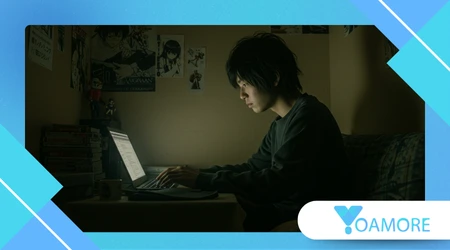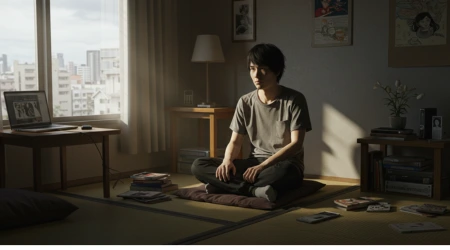La vida de los hikikomori japoneses: una subcultura de interior en crecimiento

Las vidas de los hikikomori de Japón Comienzan tras una puerta cerrada. Estos individuos, a menudo etiquetados como reclusos sociales, viven completamente aislados de la sociedad durante largos periodos, a veces años o décadas.
Anuncios
Este comportamiento no es simplemente una preferencia personal, sino una manifestación de intensas presiones sociales, académicas y familiares que empujan a algunos a elegir la soledad en lugar de la lucha.
Aunque comúnmente se asocia con la introversión extrema, el término Hikikomori Ha adquirido un mayor peso cultural en Japón.
Ahora representa una subcultura más amplia, arraigada en la resistencia, el trauma y, en algunos casos, la resiliencia silenciosa.
Este artículo analiza las causas y la evolución de este fenómeno, analiza sus impactos sociales y económicos y explora cómo están respondiendo la sociedad japonesa y otras naciones.
Anuncios
Descubrirás cómo el aislamiento ha formado una microcultura única que desafía nuestras suposiciones sobre la productividad, la salud mental y la conexión humana.
Ollas a presión: Cuando el conformismo se vuelve intolerable
La sociedad japonesa valora la disciplina, la armonía y el éxito. Desde pequeños, se enseña a los niños a valorar la pertenencia a un grupo por encima de la individualidad, y el rendimiento académico es primordial.
Los estudiantes hacen malabarismos entre días completos en la escuela y tardes en la escuela. juku (escuelas de refuerzo), que a menudo dejan poco tiempo para el descanso o la exploración personal.
Esta presión no desaparece en la edad adulta. El mundo corporativo exige lealtad, largas jornadas y una productividad incesante.
El no cumplir con estas expectativas, ya sean académicas, profesionales o sociales, puede generar una profunda vergüenza.
El Vidas de los hikikomori de Japón A menudo comienzan como una respuesta a esta estructura implacable.
Un adolescente acosado en la escuela, un recién graduado que no puede encontrar un empleo estable o un empleado abrumado por las expectativas laborales pueden retirarse silenciosamente.
Según el Ministerio de Salud, Trabajo y Bienestar de Japón, el aumento de casos de Hikikomori está fuertemente vinculado a traumas tempranos, conflictos interpersonales y expectativas de género rígidas.
Esto revela un sistema que valora el rendimiento por encima del bienestar emocional.
Lea también: Las microculturas estéticas de TikTok explicadas
Un fenómeno en expansión: de Japón al mundo

Aunque alguna vez se consideró que el hikikomori era una condición exclusivamente japonesa, esa noción está cambiando.
Los investigadores ahora identifican comportamientos similares en todos los continentes, desde Italia bamboccioni (adultos que nunca salen de la casa de sus padres) a los NEET estadounidenses (que no trabajan, ni estudian, ni reciben formación).
Un informe de 2023 de la Oficina del Gabinete de Japón estimó que... 1,46 millones de hikikomori a nivel nacional. Sin embargo, los especialistas advierten que la cifra real probablemente sea mayor debido a la falta de denuncia y al estigma.
En Corea del Sur y Taiwán, los investigadores informan que hay un número cada vez mayor de jóvenes socialmente retraídos que muestran patrones similares.
En los países occidentales, el auge del trabajo remoto, las redes sociales y la precariedad económica han dado lugar a un aislamiento comparable entre los adultos jóvenes.
El Vidas de los hikikomori de Japón Servir como un sistema de alerta temprana para la crisis de salud mental que está surgiendo globalmente en naciones altamente industrializadas.
+ La resistencia silenciosa de los contrabandistas de libros en el pasado de Lituania
Detrás de la puerta: La anatomía del aislamiento

Un ejemplo sorprendente es el de Ryota, un hombre de 32 años que no ha salido de su apartamento de Tokio en más de ocho años.
Su familia le deja comida en la puerta y él se comunica mediante mensajes de texto o trozos de papel.
El día a día de Ryota gira en torno al manga, los videojuegos y los foros. Aunque no ha hablado con nadie en persona en años, mantiene una vibrante presencia en línea en las comunidades de anime y videojuegos.
Para hikikomori como Ryota, su habitación es a la vez un capullo y una celda. Si bien la vida digital puede ofrecer entretenimiento e incluso ingresos, también puede profundizar la desconexión.
Los algoritmos tienden a reforzar sus puntos de vista y, sin interacción física, su visión del mundo se estrecha.
Otra historia trata sobre Kanae, quien usó el arte para reconectarse gradualmente con el mundo. Tras cinco años de aislamiento, comenzó a publicar bocetos en acuarela en línea, y con el tiempo vendió impresiones y se unió a un grupo local de arteterapia en Yokohama. El arte se convirtió en su primer paso hacia la sanación.
Estas historias subrayan la complejidad de la vida de los hikikomori. No son ociosos ni apáticos; se las arreglan de la única manera en que se sienten seguros.
Lea también: La cultura pesquera del Ártico de la que nunca has oído hablar
Internet: ¿salvavidas o laberinto?
Las herramientas digitales brindan a los hikikomori acceso a comunidades virtuales, comercio electrónico, trabajo freelance y entretenimiento. En algunos casos, les permiten una sensación de normalidad.
Sin embargo, esta misma tecnología puede consolidar el aislamiento. Las plataformas de redes sociales y los foros en línea permiten a los usuarios evitar por completo la interacción física, alimentando la ilusión de interacción social y reforzando la soledad.
Para muchos hikikomori, internet es su único puente hacia el mundo exterior. Pero ¿ese puente los lleva a la salida o simplemente les ofrece una cueva más cómoda?
Consecuencias económicas y sociales
Las consecuencias del aislamiento social generalizado no son meramente personales. La crisis demográfica de Japón, caracterizada por una tasa de natalidad en descenso y un envejecimiento de la población, agrava el problema.
Los padres que apoyan a sus hijos adultos Hikikomori hasta sus años de vejez crean lo que ahora se conoce como el “problema 8050”.
Este término se refiere a familias en las que padres de 80 años todavía mantienen a hijos de 50 años sin ingresos.
Un estudio de la Universidad de Tokio en 2024 reveló que Japón pierde aproximadamente 2,5 billones de yenes al año debido a la participación inactiva de la fuerza laboral relacionada con Hikikomori.
Además, los cuidadores sufren fatiga emocional, dificultades económicas y vergüenza social. Esta carga silenciosa fractura las relaciones familiares y aísla no solo a los hikikomori, sino a todos sus hogares.
Respuestas del Gobierno: Hay espacio para la reforma
El gobierno japonés ha puesto en marcha iniciativas como centros de apoyo regionales, líneas telefónicas de asesoramiento y formación laboral subvencionada.
Sin embargo, los críticos argumentan que muchos de estos programas no comprenden la naturaleza profundamente individualizada de las experiencias de los Hikikomori.
Un enfoque estandarizado —que fuerza la reinserción en sistemas rígidos— suele ser contraproducente. En cambio, los expertos recomiendan una atención adaptada al trauma, sistemas de apoyo al paciente y vías de reintegración no lineales.
Por ejemplo, New Start, una organización sin fines de lucro con sede en Tokio, opera “casas de paso”, hogares compartidos donde los hikikomori pueden interactuar gradualmente con otros sin ser juzgados.
Estos entornos de transición ofrecen estructura sin presión.
De la microcultura al espejo: lo que los hikikomori nos revelan
El Vidas de los hikikomori de Japón Desafiar a la sociedad global a reevaluar sus definiciones de éxito, comunidad y salud mental.
¿Qué dice sobre la vida moderna el hecho de que tantas personas prefieran desaparecer antes que participar?
Se podría argumentar que los Hikikomori no simplemente reaccionan a las normas japonesas, sino a fallas universales en cómo estructuramos el trabajo, la educación y la autoestima.
En una cultura hiperproductiva, optar por no participar se convierte en una forma de protesta.
Su existencia revela que nuestros sistemas pueden no ser defectuosos sólo para unos pocos, sino también fundamentalmente insostenibles para muchos.
La microcultura de Hikikomori refleja una tensión creciente entre la agencia personal y las expectativas sociales.
Silencio cultural: estigma y vergüenza
En Japón, quedar mal parado es una de las consecuencias más temidas. Las familias con miembros de Hikikomori suelen guardar silencio, lo que aísla aún más a la persona y retrasa la intervención.
La imagen que los medios de comunicación han mostrado no ha ayudado. A menudo se representa a los hikikomori como perezosos o peligrosos, lo que refuerza estereotipos dañinos.
Como resultado, muchos sufren en silencio y sus familias quedan atrapadas en ciclos de culpa y confusión.
Los expertos instan a un cambio de narrativa: de la vergüenza al apoyo. Las campañas de concienciación pública, los programas educativos y el periodismo compasivo pueden contribuir a construir una cultura de empatía en lugar de exclusión.
Caminos emergentes: repensando la reintegración
La verdadera recuperación no implica necesariamente reincorporarse al mercado laboral tradicional ni adaptarse a las normas sociales. Puede implicar descubrir nuevas formas de involucrarse, en sus propios términos.
El trabajo remoto, la educación en línea y el arte terapéutico se utilizan cada vez más para ayudar a los hikikomori a encontrar significado y conexión. El objetivo no es imponer la conformidad, sino crear un espacio para estilos de vida diversos.
Ahora se alienta a los responsables de las políticas y a los profesionales de la salud mental a ver a los Hikikomori no como problemas a resolver, sino como personas a las que acompañar en viajes hacia una curación autodefinida.
Preguntas frecuentes (FAQ)
¿Qué es exactamente un Hikikomori?
Una persona que se retira de la sociedad, evita la interacción social y permanece aislada en casa durante seis meses o más, a menudo debido a desafíos emocionales o sociales.
¿Se considera el hikikomori una condición médica?
No formalmente, pero muchos Hikikomori experimentan problemas de salud mental como depresión, ansiedad o trastornos relacionados con traumas.
¿Puede alguien recuperarse del estado de Hikikomori?
Sí. La recuperación puede ocurrir gradualmente a través de terapia, apoyo comunitario y opciones de reingreso flexibles adaptadas a las necesidades individuales.
¿Esto ocurre sólo en Japón?
No. Se observan comportamientos de retraimiento social similares en todo el mundo, aunque Japón sigue siendo el caso más estudiado y con mayor vínculo cultural.
¿Cómo pueden las familias apoyar a un miembro de Hikikomori?
Evite el lenguaje basado en la vergüenza, mantenga una comunicación amable y busque ayuda de profesionales o grupos de apoyo familiarizados con la dinámica Hikikomori.
